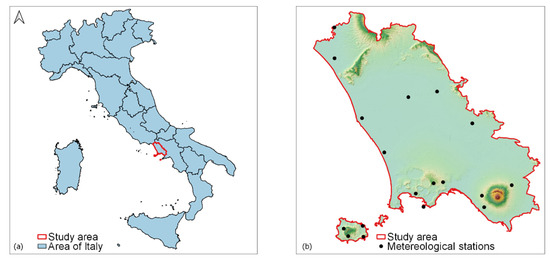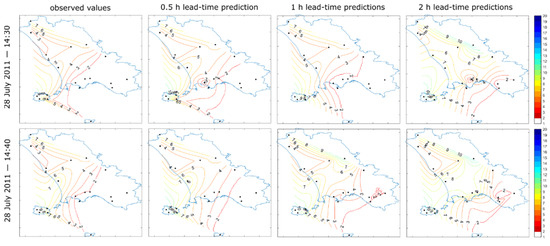Abstract
During emergency situations, short-term rainfall forecasting is crucial for human life-saving and economic damage mitigation. However, due to the high interconnection among the meteorological variables, the rainfall evolution mechanism is challenging to predict. Since machine-learning techniques do not require any previous physical assumption, this study suggests a rainfall nowcasting model based on Artificial Neural Networks. The proposed model provides punctual rainfall predictions at three different lead times: 30 min, 1 h, and 2 h. The analysis is based on 10 years of records from meteorological stations over the Campania region, southern Italy. Several feed-forward neural network models were trained with 350 spatial rainfall events, with 10 min time step. The approach produced consistent predictions and learned the relationship describing space-time rainfall evolution. Characterized by high update frequency and short computational time, the procedure is suitable for real-time early warning systems.
1. Introduction
Nowcasting refers to a forecast over a short time, generally up to 6 h. During emergency situations, it influences human life-saving and economic damage mitigation [1,2]. To promptly evaluate critical situations, a nowcasting system requires a succession of forecasts characterized by high update frequency and short computational time [3]. However, the rainfall evolution mechanism is difficult to identify and model, and consequently, rainfall nowcasting has always been a complex problem [4]. Moreover, existing models use complex statistical approaches that are often too costly, both computationally and budgetarily [5].
Recently, machine-learning models have proved to be the most feasible technique to extract hidden patterns from historical rainfall data [6]. They are willing when it is not easy to recognize all the existing complex and typically non-linear relationships of the dynamical rain process [7]. Therefore, this study investigates the machine-learning ability to provide efficient and timely short-term predictions.
The proposed model employs cumulative rainfall fields to predict 30 to 120 min ahead rain interval, using only the current field as input. It is a spatio-temporal approach that combines both temporal (cumulative rainfall depth) and spatial (cumulative rainfall field) information. This strategy enables the model to predict short-term punctual rainfall using only the current measurements as input, resulting in a rapid, easily replicable, and convenient nowcasting approach.
The procedure is an effective way to predict multi-step rainfall fields and is suitable for operational early warning systems.
2. Materials and Methods
2.1. Study Area and Database
The study area is the western part of the Campania Region, located in southern Italy (Figure 1a). It has an area of 1619 km2 and is characterized by a rain gauge density of 0.01 station/km2 (Figure 1b).

Figure 1.
Location of the study area within Italy (a) and with the corresponding elevation and rain gauge stations network (b).
The database includes 10 min time series with record periods from 2000 to 2019, acquired by Campania Region Department of Civil Protection (DPC) over the study area. The models were trained with 350 spatial rainfall events that occurred over the study area.
2.2. Model Set Up
For each station over the study area and for each lead time considered, a feed-forward neural network model was developed. The model employs the cumulative precipitation field at time t0 to predict the punctual rainfall interval at time t0 + DT, with DT equal to the lead time.
Before passing through the feed-forward neural networks, the registrations are first pre-processed. Indeed, input data are discretized into intervals to enhance predictive accuracy while reducing input variance [8].
2.3. Training Strategy
To develop and test the model, the dataset was divided into three parts: training, validation, and test set. The first one was used to train the model by tuning its parameters with the back-propagation algorithm [9]. Validation set asserted generalizing ability and avoided overfitting, which happens when the model is performing well on the data used during training but performs poorly on new unseen data [10]. Finally, once the parameters of the models have been defined, test set was used for final model evaluation.
2.4. Performance Criteria
The performance of each model was evaluated and compared using four different metrics: Mean Absolute Error (MAE), Root Mean Square Error (RMSE), determination Coefficient (R2), and Nash–Sutcliffe Efficiency index (NSE).
where Obs is the observed value, Pred is the predicted value, the average of the observations, and n is the number of examples.
3. Results and Discussion
The first sub-section presents model performance and how the lead time influences some statistics, while Section 3.2 shows the results for some events.
3.1. Nowcast Performance
According to the indicators, 30 min ahead models produced the best performance, while 2 h ones were the worst. MAE and RMSE mean values increase from 0.4352 mm to 1.444 mm and from 1.6735 mm to 3.6998 mm, respectively (Table 1).

Table 1.
Comparison of the average scores of different models over three lead times.
These trends are broadly consistent with physical behavior. Indeed, it is widely recognized that as the forecast lead time increases, the correlation between the desired output and available input decreases [11,12]. Consequently, rainfall forecasts deteriorate with increasing lead time.
R2 and NSE reveal the opposite trend mentioned above: the values decrease with increasing lead times. However, notwithstanding the decreasing trend, the values are all higher than 0.9068. Thus, they all are within their optimal range, confirming the goodness-of-fit of the models.
3.2. Events on 28 July 2011
The results of the events are presented in terms of the rainfall pattern in two control instants: 28 July 2011—14:30 and 14:40 (Figure 2).

Figure 2.
Comparison between observed values and prediction of the three models in terms of rain depth (Time is in CET).
The 0.5 h lead time predictions are in good agreement with the observed values, both in pattern recognition and in the overall intensity trend, which is mainly due to two reasons. First, the short-lead time helps the model to capture the spatiotemporal dependencies and learn the details of the rainfall process. Second, the collaborative learning from cumulative rainfall fields and data pre-processing allowed the high performance of model prediction.
On the other hand, the performance of the 2 h ahead model deviates from the observed data in the longer-term forecast. This drawback is mainly due to the insufficient modeling ability of the models and their difficulty in capturing the long-range temporal dependencies.
According to the results, it is evident that there is consistent physical behavior, which is not obvious when dealing with machine-learning techniques. However, since the method produced reliable and consistent precipitation nowcasts, it can be said that the training strategy was successful.
4. Conclusions
This study investigated rainfall nowcasting performance based on machine-learning algorithms. A method that enhances rainfall forecasting employing rainfall fields was developed. The analysis was based on 10 years of registrations from meteorological stations over the study area, located in southern Italy. Almost 350 rainfall events were used to train, validate, and test the models.
Generally, all the models produced consistent predictions and learned the complex relationship describing space-time rainfall evolution. Additionally, predictive accuracy gradually decreases as the lead time increase, according to physically-based models.
The results motivate further research into the application of machine learning to precipitation estimation using cumulative precipitation fields.
Author Contributions
Conceptualization, D.P. (Dina Pirone) and L.C.; methodology, D.P (Dina Pirone); software, D.P. (Dina Pirone); validation, D.P. (Dina Pirone); formal analysis, D.P. (Dina Pirone); investigation, D.P. (Dina Pirone); resources, G.D.G.; data curation, D.P. (Dina Pirone); writing—original draft preparation, D.P. (Dina Pirone); writing—review and editing, D.P. (Dina Pirone); visualization, D.P. (Dina Pirone); supervision, G.D.G. and D.P. (Domenico Pianese); project administration, G.D.G. All authors have read and agreed to the published version of the manuscript.
Funding
This work was supported by the “Inspiring” PRIN Project 2020 funded by the Italian MIUR [grant number 2020NTSFXF].
Institutional Review Board Statement
Not applicable.
Informed Consent Statement
Not applicable.
Data Availability Statement
Not applicable.
Acknowledgments
The authors of this work are grateful to the Campania Region Department of Civil Protection (DPC), Naples, Italy, for having granted access to rainfall data acquired by their monitoring rain-gauge network.
Conflicts of Interest
The authors declare no conflict of interest.
References
- De Luca, D.L.; Capparelli, G. Rainfall Nowcasting Model for Early Warning Systems Applied to a Case over Central Italy. Nat. Hazards 2022, 112, 501–520. [Google Scholar] [CrossRef]
- Zhou, S.; Wang, Y.; Yuan, Q.; Yue, L.; Zhang, L. Spatiotemporal Estimation of 6-Hour High-Resolution Precipitation across China Based on Himawari-8 Using a Stacking Ensemble Machine Learning Model. J. Hydrol. 2022, 609, 127718. [Google Scholar] [CrossRef]
- WMO. Guidelines for Nowcasting Techniques; WMO: Geneva, Switzerland, 2017; ISBN 9789263111982. [Google Scholar]
- French, M.N.; Krajewski, W.F.; Cuykendall, R.R. Rainfall Forecasting in Space and Time Using a Neural Network. J. Hydrol. 1992, 137, 1–31. [Google Scholar] [CrossRef]
- Barrera-Animas, A.Y.; Oyedele, L.O.; Bilal, M.; Akinosho, T.D.; Delgado, J.M.D.; Akanbi, L.A. Rainfall Prediction: A Comparative Analysis of Modern Machine Learning Algorithms for Time-Series Forecasting. Mach. Learn. Appl. 2022, 7, 100204. [Google Scholar] [CrossRef]
- Huang, L.; Xiang, L.Y. Method for Meteorological Early Warning of Precipitation-Induced Landslides Based on Deep Neural Network. Neural Process. Lett. 2018, 48, 1243–1260. [Google Scholar] [CrossRef]
- Asghari, K.; Nasseri, M.; Wolpert, D.H.; Macready, W.G.; Chandler, R.E.; Mackay, N.G.; Wheater, H.S.; Onof, C.; De Luca, D.L.; Capparelli, G.; et al. Spatial Rainfall Prediction Using Optimal Features Selection Approaches. Hydrol. Res. 2015, 46, 343–355. [Google Scholar] [CrossRef]
- Moon, S.H.; Kim, Y.H.; Lee, Y.H.; Moon, B.R. Application of Machine Learning to an Early Warning System for Very Short-Term Heavy Rainfall. J. Hydrol. 2019, 568, 1042–1054. [Google Scholar] [CrossRef]
- Htike, K.K.; Khalifa, O.O. Rainfall Forecasting Models Using Focused Time-Delay Neural Networks. In Proceedings of the 8th International Conference on Computer and Communication Engineering (ICCCE), Kuala Lumpur, Malaysia, 11–12 May 2010; pp. 11–13. [Google Scholar]
- Song, Y.; Han, D.; Rico-Ramirez, M.A. High Temporal Resolution Rainfall Information Retrieval from Tipping-Bucket Rain Gauge Measurements. Procedia Eng. 2016, 154, 1193–1200. [Google Scholar] [CrossRef][Green Version]
- Lin, G.F.; Chen, G.R.; Wu, M.C.; Chou, Y.C. Effective Forecasting of Hourly Typhoon Rainfall Using Support Vector Machines. Water Resour. Res. 2009, 45, 1–11. [Google Scholar] [CrossRef]
- Heuvelink, D.; Berenguer, M.; Brauer, C.C.; Uijlenhoet, R. Hydrological Application of Radar Rainfall Nowcasting in the Netherlands. Environ. Int. 2020, 136, 105431. [Google Scholar] [CrossRef] [PubMed]
Publisher’s Note: MDPI stays neutral with regard to jurisdictional claims in published maps and institutional affiliations. |
© 2022 by the authors. Licensee MDPI, Basel, Switzerland. This article is an open access article distributed under the terms and conditions of the Creative Commons Attribution (CC BY) license (https://creativecommons.org/licenses/by/4.0/).